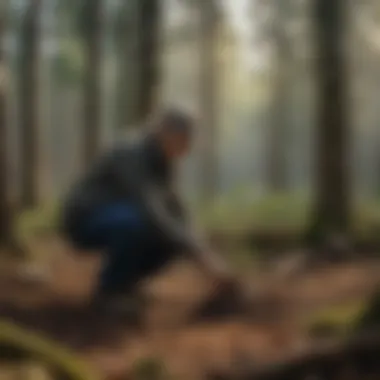Understanding Granda National: Ecology and Community


Intro
Granda National proposes a multifaceted approach to forest conservation, merging ecology, stewardship, and community engagement. This framework focuses on the principles that govern responsible management of woodlands while acknowledging the interconnectedness of human communities and natural ecosystems. To explore this concept fully, we must dissect several key areas:
- The intricate web of forest ecosystems and their undeniable importance.
- Sustainable forestry practices that ensure responsible treatment of natural resources.
- The critical role of local communities in stewardship and engagement.
Through understanding these components, we not only appreciate the value of Granda National but also grasp our collective responsibility in ecological stewardship.
Forest Ecology and Biodiversity
Forest ecosystems are an essential part of our planet's biodiversity. They provide habitat for countless species and maintain ecological balance. The significance of these ecosystems cannot be overstated; they offer more than just a scenic landscape.
Importance of Forest Ecosystems
Forests are vital for several reasons. They act as carbon sinks, absorbing CO2 from the atmosphere and thus helping mitigate climate change. Additionally, they are critical to the water cycle, influencing rainfall patterns and maintaining clean water sources. These ecosystems also provide several resources, including timber and non-timber products, which are essential for many livelihoods.
Flora and Fauna in Woodlands
Woodlands are home to a diverse array of flora and fauna. Various tree species create habitats for numerous animals. For instance, oak, pine, and maple trees provide shelter and food for many birds, mammals, and insects. The existence of this biodiversity promotes resilience in ecosystems, allowing them to adapt to environmental changes.
Understanding the dynamics of forest ecology is pivotal in promoting practices that nurture biodiversity and enhance forest health. Without healthy ecosystems, the benefits forests provide would be at risk.
Sustainable Forestry Practices
Managing forests sustainably is crucial to maintaining their health and viability. Several techniques and standards have emerged to guide responsible practices in this field.
Techniques for Responsible Management
Sustainable forestry involves various practices, which may include:
- Selective logging, which minimizes damage to surrounding trees and understory plants.
- Reduced impact logging, aimed at maintaining ecological functions and minimizing disruption.
- Reforestation, or replanting trees in harvested areas, restores ecosystems and enhances habitat.
Each of these approaches helps to ensure that forests can regenerate and continue to provide essential services.
Certification Schemes and Standards
Various certification programs, such as the Forest Stewardship Council (FSC), set standards for sustainable forestry. These certifications provide transparency and give consumers confidence that the products they buy come from responsibly managed sources. Such initiatives promote accountability among companies and encourage environmentally friendly practices across the industry.
Community Engagement and Stewardship
Effective stewardship of forests cannot occur in isolation. The involvement of local communities is essential to fostering a shared sense of responsibility.
Role of Local Communities
Local communities often possess deep knowledge of their environment, developed through generations of interaction with the land. Their participation in forest management practices ensures that approaches are rooted in local ecological realities. Additionally, these communities can advocate for conservation practices that align with their traditional customs and needs.
Volunteer Opportunities for Engagement
Community engagement comes in various forms. Individuals can participate in tree planting initiatives, habitat restoration efforts, or biodiversity monitoring programs. Engaging in volunteer opportunities empowers people to contribute directly to forest conservation, reinforcing their connection to the environment.
"Communities are the stewards of their environment, and empowering them is vital to ensuring the health of our forests."
Through community involvement and collaborative stewardship, the goals of Granda National can be realized. Each person plays a role in ensuring that forests flourish for future generations.
Understanding Granda National invites us to reflect on our place within these systems. Recognizing the importance of forest ecology, sustainable practices, and active community involvement is paramount to achieving long-term conservation goals.
Foreword to Granda National


Granda National serves as a crucial concept in the modern understanding of ecological stewardship and sustainable forestry. As environmental challenges continue to escalate, the significance of frameworks like Granda National becomes increasingly evident. It aids in bridging the gap between ecological integrity and community involvement, ensuring that both nature and society benefit from robust management practices.
One of the key elements of Granda National is its emphasis on sustainable practices. It encourages forest management strategies that preserve biodiversity while allowing for responsible resource extraction. Additionally, this approach supports local economies by promoting sustainable timber production and ecotourism. Understanding Granda National equips forestry professionals and local communities with the knowledge and tools necessary to engage in more effective woodland stewardship.
Defining Granda National
Granda National is not merely a theoretical construct but a practical framework that outlines how ecosystems, human activities, and governance intersect within forested areas. At its core, it advocates for a holistic perspective that acknowledges the interconnectedness of all living beings and their environments. Granda National incorporates various disciplines, including ecology, economics, and social sciences, thereby creating a comprehensive blueprint for management practices.
The focus is not solely on trees or wildlife but also on the communities that rely on these ecosystems for their livelihood. Key terms often associated with Granda National include sustainable forestry, biodiversity, and community engagement. These terms highlight the fact that a healthy environment depends on active participation by individuals and organizations at all levels.
Historical Overview
The historical context of Granda National provides essential insights into its development and implementation. Various movements toward forest sustainability began gaining traction in the late 20th century. Early practices primarily focused on conservation and protection of endangered species and habitats. However, as ecological degradation continued, it became clear that more integrated and sustainable approaches were necessary.
Granda National emerged from a synthesis of these ideas. It incorporates lessons learned from past successes and mistakes, striving to create a framework that is adaptable to changing environmental conditions. Understanding this evolution allows us to appreciate the complexities involved in modern forestry and woodland management.
Moreover, the role of various stakeholders—ranging from government agencies to local communities—has been pivotal in shaping the principles of Granda National. The movement has witnessed various grassroots campaigns advocating for both environmental protection and community involvement, illustrating the necessity of collaboration for effective stewardship.
Ecological Importance of Woodlands
Woodlands play a vital role in maintaining ecological balance and fostering biodiversity. In the context of Granda National, understanding these ecological benefits is crucial for promoting better management practices and fostering sustainable interactions between humans and nature. Woodlands serve as habitat for countless species, facilitate nutrient cycling, and contribute to overall forest health. These ecosystems are not merely passive landscapes; they are dynamic systems that actively contribute to environmental stability.
Role in Biodiversity Conservation
Biodiversity conservation is one of the most significant benefits offered by woodlands. They house a wide range of flora and fauna, contributing to genetic diversity essential for resilient ecosystems. Diverse ecosystems can better withstand environmental stressors, such as diseases and climate fluctuations. In Granda National, the various tree species and understory plants create microhabitats for numerous animals, from birds to insects. This rich biodiversity supports food webs, ensuring that both predator and prey species can thrive. Additionally, protecting these woodlands can help prevent species extinction, particularly for those that are endemic or threatened.
The interconnectedness of species within these ecosystems also has implications for human well-being. For example, many medicinal plants are found in woodland areas. By preserving these habitats, we ensure that these valuable resources remain available for future generations.
Carbon Sequestration Benefits
Carbon sequestration is another critical function of woodlands. Trees absorb carbon dioxide from the atmosphere, helping to mitigate greenhouse gas emissions. This process is particularly crucial in the face of ongoing climate change. In Granda National, forests play a fundamental role in offsetting carbon emissions, thus contributing towards global climate stabilization. The biomass of trees acts as a significant carbon sink.
- A mature tree can absorb approximately 48 pounds of carbon dioxide annually.
- Woodlands can store vast quantities of carbon in their vegetation and soil layers.
By fostering healthy forest ecosystems, Granda National stands as a model for effective carbon management strategies. Proper stewardship and innovative forest practices can enhance this capability, thereby maximizing the benefits of woodlands.
"Woodlands are more than just resources; they are essential components of our ecological infrastructure, aiding in climate regulation and biodiversity preservation."
Understanding the ecological importance of woodlands in Granda National is key to informed policy-making and community engagement efforts. By emphasizing their role in biodiversity conservation and carbon sequestration, we can frame environmental stewardship as not just a responsibility, but an opportunity for collective action in the face of pressing challenges.
Sustainable Management Practices
Sustainable management practices are vital to maintaining the health and integrity of woodlands within Granda National. These practices encompass various strategies that prioritize ecological balance while meeting the needs of local communities and economies. Implementing sustainable approaches not only conserves resources but also enhances biodiversity and promotes resilience against environmental changes.
In the context of forestry, sustainable management involves careful planning and monitoring of forest resources. This includes understanding the growth rates of trees, the health of soil, and the needs of different species within the ecosystem. The benefits of such practices are manifold:
- Ecosystem Resilience: Sustainable management helps forests adapt to disruptions, such as climate changes or pest outbreaks.
- Resource Optimization: Careful planning ensures that timber and non-timber resources are harvested in a manner that allows for regeneration.
- Community Benefit: Practices that engage the local community lead to better stewardship and investment in forest health.
Considering these factors is essential for long-term sustainability and for the future of Granda National.
Best Practices in Woodland Care
When managing woodlands, best practices play a crucial role in ensuring the health of the habitat. These practices include:
- Regular Monitoring: Keeping track of tree health and growth is crucial. This involves periodic assessments to inform management decisions.
- Selective Logging: Instead of clear-cutting, selective logging allows for the sustainable harvest of timber while maintaining ecological balance.
- Reforestation: Planting new trees after harvesting creates a cycle of growth and ensures continuous coverage.
- Soil Conservation: Protecting soil through strategies like mulching or ground cover planting enhances soil health.
Implementing these strategies promotes healthier woodlands and sustains biodiversity.


Innovative Forestry Techniques
Modern forestry has seen the introduction of innovative techniques that advance traditional methods. Embracing technology is a key element in sustainable forest management. Some notable techniques include:
- Precision Forestry: Using data and technology to optimize harvest schedules and locations. This approach reduces waste and increases productivity.
- Agroforestry: Integrating agriculture and forestry practices helps to enhance land use efficiency while providing multiple benefits, such as improved biodiversity and optimized resource use.
- Biotechnology: Utilizing genetic research to develop tree varieties that are more robust against diseases and climate changes.
By integrating innovative forestry techniques into the management of Granda National, we can create a more sustainable future for woodlands. This will lead to a harmonious relationship between conservation efforts and community development.
Community Involvement in Granda National
Community involvement is a vital aspect of Granda National. It enables local populations to connect with their natural surroundings, fostering a sense of responsibility and stewardship. This relationship is critical not only for preserving woodlands but also for enhancing the quality of life within communities. Engaging residents in conservation efforts cultivates a shared vision for managing forests that aligns with ecological values and local needs. Community involvement also promotes awareness about the importance of sustainable practices, ensuring these principles are passed down through generations.
Grassroots Movements
Grassroots movements play a significant role in the ecosystem of Granda National. These initiatives emerge from local citizens who are passionate about forest conservation and wish to take action. Such movements often organize events like tree planting, clean-up days, and educational workshops, bolstering community spirit and connection to the land. By empowering individuals to take ownership of their environment, grassroots movements help foster long-lasting change that extends beyond compliance with regulations.
Grassroots movements remind us that small actions can lead to significant transformations in how we approach ecology and stewardship.
These efforts can lead to positive environmental impacts and enhance community ties, creating a collective identity centered around sustainability.
Educational Initiatives
Educational initiatives are essential for the success of community involvement in Granda National. These programs range from school-based curricula to public seminars and workshops. They aim to raise awareness about the ecological importance of woodlands, the principles of sustainable management, and the benefits of eco-friendly practices. Partnerships between local schools, nonprofit organizations, and forestry experts enhance the effectiveness of these initiatives.
Through educational initiatives, individuals gain knowledge and skills required to engage actively in conservation efforts. Topics may include identifying native species, understanding the carbon cycle, and recognizing the effects of climate change on local ecosystems. Such knowledge empowers community members to participate in informed discussions and decision-making regarding forestry policy and conservation strategies.
In summary, community involvement is crucial for fostering a sense of collective responsibility towards woodland conservation in Granda National. Grassroots movements and educational initiatives are pivotal components of this involvement, driving engagement and promoting sustainable practices.
Economic Impacts of Forestry Practices
The topic of economic impacts in forestry practices holds significant weight in the context of Granda National. Understanding how these practices influence not only the environment but also local economies and communities is essential. Forestry is not just about trees and landscapes; it's also about the sustainability of livelihoods and ecosystems. By analyzing the economic aspects of forestry, we can highlight its role in development, conservation, and maintaining a balance between human needs and ecological health.
Sustainable Timber Production
Sustainable timber production is a cornerstone of economic viability within Granda National. It involves practices that allow for continual harvest of timber without degrading the forest ecosystem. This approach not only ensures a stable supply of high-quality wood products but also promotes biodiversity and safeguards soil integrity.
In sustainable timber production, several considerations must be accounted for. These include:
- Selective logging: This restricted method minimizes impact on surrounding trees and wildlife.
- Reforestation efforts: Planting new trees to replace those harvested helps maintain forest density and carbon absorption.
- Certification schemes: Organizations such as the Forest Stewardship Council (FSC) ensure that timber harvested meets established sustainability criteria.
Engaging in sustainable timber production can generate substantial economic benefits. It can contribute to local economies through job creation, creation of local industries, and the provision of raw materials for construction and furniture markets.
Ecotourism Opportunities
Ecotourism presents another vital economic opportunity linked to forestry practices. Within Granda National, promoting natural resources as attractions for visitors fosters awareness and preservation of local environments. Ecotourism encourages a minimal-impact way of experiencing nature while providing financial incentives that help sustain the woodlands.
Key benefits of ecotourism in this context include:
- Economic diversification: Communities can reduce reliance on single revenue streams by integrating tourism.
- Education and awareness: Encouraging visitors to understand the ecological importance of Granda National can lead to increased support for conservation efforts.
- Funding for conservation projects: Revenue generated through ecotourism can be reinvested into sustainable practices, ensuring environmental health and stability.
"Ecotourism is a way for communities to engage with their environment while also benefiting economically. It intertwines conservation with local prosperity."
By addressing these economic impacts, stakeholders can navigate the challenges and opportunities that arise from forestry practices. Understanding the balance between sustainability and economic growth is crucial for the future of Granda National.
Challenges Facing Woodland Stewardship
Woodland stewardship plays a crucial role in the sustainability of natural ecosystems. However, it faces several significant challenges that can undermine its effectiveness. Understanding these challenges is vital for forestry professionals and academic researchers, as they navigate the complexities of ecological balance and community engagement. Addressing these issues contributes to the long-term health of woodlands and supports both environmental goals and community needs.


Climate Change Effects
Climate change represents one of the most profound threats to woodland ecosystems. Increasing temperatures, changing precipitation patterns, and more frequent extreme weather events disrupt the delicate balance that forests depend on. These shifts can lead to shifts in species distributions, increase in pest outbreaks, and alter fire regimes. For instance, certain tree species may struggle to survive in conditions that once favored them. As a result, biodiversity may be severely affected, which can weaken ecosystem resilience.
The implications of climate change also extend to carbon sequestration. Forests are critical carbon sinks, and their ability to absorb CO2 diminishes as they become stressed. This feedback loop not only exacerbates climate change but also threatens the effectiveness of woodland stewardship initiatives aimed at promoting sustainability. Consequently, adapting management practices to account for climate change is more urgent than ever.
Policy and Regulatory Hurdles
In addition to climate-related issues, policy and regulatory hurdles present a significant challenge to woodland stewardship. Existing regulations often do not account for new scientific findings or emerging conservation practices. Bureaucratic inertia can slow the implementation of effective management strategies, leaving ecosystems vulnerable.
Moreover, the complexities of multiple land-use policies can create conflicts. For instance, policies that promote urban development may clash with environmental protection efforts. Stakeholders often find themselves navigating a web of local, state, and federal regulations that might not align. This situation complicates community engagement and stewardship initiatives, making it crucial for policymakers to initiate dialogues that integrate ecological science with land-use planning.
"Navigating the intricate landscape of policies requires collaboration among stakeholders to achieve sustainable outcomes."
By recognizing these challenges, forestry professionals and academic researchers can develop targeted strategies that promote resilience in woodland stewardship while enhancing community engagement in conservation efforts.
Future Directions for Granda National
The future of Granda National hinges on advancing methodologies, enhancing ecological stewardship, and cultivating deeper community involvement. By acknowledging its role in environmental sustainability, Granda National not only addresses its own challenges but also positions itself as a model for other forested areas. Engaging with emerging trends and incorporating innovative management techniques will ensure that this framework remains relevant and effective in the face of evolving environmental conditions.
Emerging Trends in Forestry
As the landscape of global forestry continues to evolve, several trends are starting to gain traction within Granda National’s stewardship framework. These trends highlight a shift towards more sustainable practices, creating a better balance between ecological integrity and economic viability.
- Agroforestry Integration: This approach combines agriculture with forestry, allowing for more diverse land use. It maximizes yields while preserving ecological balance. Farmers increasingly adopt agroforestry as a means of improving soil health and biodiversity.
- Regenerative Practices: A focus on restorative techniques emerges to enhance soil health and biodiversity. Practices such as cover cropping and no-till farming are gaining momentum. These methods aim to replenish ecosystems rather than merely exploit them.
- Community-Led Management: Engaging local communities in decision-making processes fosters inclusivity. It also leads to solutions that reflect the unique needs of the ecosystem and stakeholders involved. Collaboration enhances the effectiveness of conservation measures.
"The transformation in forestry practices towards inclusivity is vital for the resilience of ecosystems and community welfare."
Incorporating these trends is not merely academic; they reflect the realities of global climate challenges and economic pressures. The innovative paths being forged can offer tangible benefits in the long-term stewardship of Granda National.
The Role of Technology in Management
Advancements in technology are proving invaluable in the management of Granda National. The application of these tools allows for more effective monitoring, assessment, and interventions across woodland areas. Key technological advancements include:
- Remote Sensing: This technology enables forest managers to assess large areas efficiently. Drones and satellite imagery provide critical data on forest health, ensuring that managers can act quickly in response to threats like disease or invasive species.
- Data Analytics: Integrating big data into forest management decisions aids in predictive analytics. Utilizing this can forecast environmental changes, allowing for proactive strategies instead of reactive ones.
- Mobile Applications: Modern applications facilitate community engagement in conservation efforts. They can help residents track local wildlife, report issues, and participate in area stewardship activities.
These technologies do not replace the human element but rather enhance it. By empowering forestry professionals with data and tools, they can make informed decisions that lead to improved ecological outcomes. With careful application, technology can significantly elevate the efficacy of initiatives within Granda National.
In summary, the future directions for Granda National involve the seamless integration of emerging trends and advanced technologies. By doing so, the framework not only preserves the rich resources of the woodlands but also sets a benchmark for collective stewardship.
End: Collective Responsibility
The topic of collective responsibility is crucial within the framework of Granda National. It illustrates the shared obligation to protect and sustain woodlands, emphasizing that individual efforts contribute to a larger goal. The future of our ecologies is intertwined with human activity. Thus, understanding this synergy is paramount for all stakeholders.
One key element is accountability. Stakeholders, from local communities to larger organizations, must actively engage in sustainable practices. This creates a ripple effect, fostering a culture of awareness and action. Additionally, the involvement of diverse groups ensures that various perspectives are integrated into woodland management, leading to more effective solutions.
Benefits of Collective Responsibility:
- Enhanced Biodiversity: When communities collaborate, they create habitats that support a broader range of species.
- Improved Resource Utilization: Shared knowledge and resources often result in more efficient forestry practices.
- Greater Resilience to Climate Change: Collective actions can lead to more robust ecosystems, better equipped to adapt to environmental changes.
Moreover, there are important considerations. Engaging communities in stewardship requires ongoing education and outreach. Without understanding the ecological principles behind their involvement, efforts may falter. The balance of power must also be maintained. Equitable participation ensures no single group dominates the discourse, respecting all voices.
Summarizing the Key Points
As we reflect on the discussions surrounding Granda National, several key points stand out:
- Ecosystem Interdependence: The health of woodlands relies on both natural and human processes.
- Importance of Community Engagement: Local involvement is essential for successful conservation efforts.
- Challenges Ahead: Climate change, regulatory hurdles, and economic factors pose significant risks.
- Collective Action: Each stakeholder's contribution leads to a shared outcome, enhancing overall sustainability.
Call to Action for Stakeholders
In light of these insights, it is imperative for stakeholders to take deliberate action. Here are steps that can be considered:
- Participate in Training Programs: Gain knowledge on sustainable practices and how to implement them effectively.
- Support Local Initiatives: Invest time or resources in community-based forestry projects.
- Advocate for Policy Changes: Push for regulations that promote ecological stewardship at all levels.
- Foster Partnerships: Collaborate with other organizations and communities to enhance resource sharing and knowledge transfer.
Granda National represents a commitment to a sustainable future. It requires action from everyone involved. Only through collaborative efforts can we hope to preserve woodlands and the ecological balance they support.















